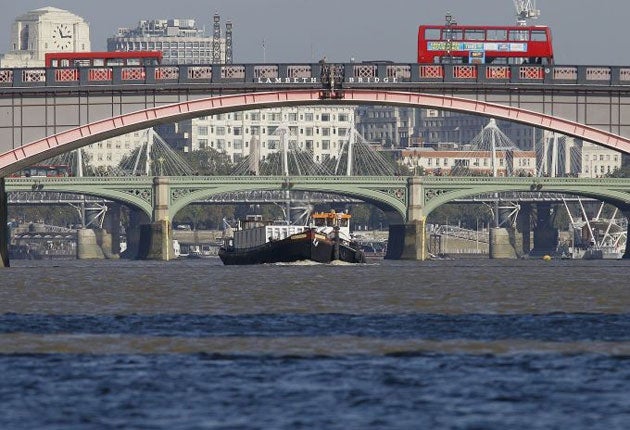Thames: The tale that the river told
Fifty years ago, it was biologically dead. In 2010, the Thames is in rude health. It's a transformation with huge implications, says Alice-Azania Jarvis

Your support helps us to tell the story
From reproductive rights to climate change to Big Tech, The Independent is on the ground when the story is developing. Whether it's investigating the financials of Elon Musk's pro-Trump PAC or producing our latest documentary, 'The A Word', which shines a light on the American women fighting for reproductive rights, we know how important it is to parse out the facts from the messaging.
At such a critical moment in US history, we need reporters on the ground. Your donation allows us to keep sending journalists to speak to both sides of the story.
The Independent is trusted by Americans across the entire political spectrum. And unlike many other quality news outlets, we choose not to lock Americans out of our reporting and analysis with paywalls. We believe quality journalism should be available to everyone, paid for by those who can afford it.
Your support makes all the difference.Filthy, opaque and stinking of rotten eggs: this was the River Thames of 1957. Declared biologically dead thanks to its soaring pollution levels, Britain's most famous waterway was paying the price for decades of human use – and not for the first time. Since the 18th century, it has been a hotbed of industrial activity; during the "Great Stink" of 1858, the stench of human waste along the riverbanks forced Parliament to drench its curtains in chloride of lime and almost prompted the city's law courts' evacuation to St Albans.
A century and a half later, things look rather different. With 125 different species of fish navigating its curves, 400 invertebrates wallowing in its mud, and a selection of seals, otters and dolphins to be spotted, the Thames has achieved a transformation of staggering proportions. Eighty per cent of the Thames is now judged to have "very good" or "good" water quality, while the past five years have seen almost 400 habitat enhancement projects and more than 40 miles of river restored.
The difference hasn't gone unnoticed. Last week, the International River Symposium announced the Thames as the winner of its International Theiss River Prize, awarding the Environment Agency £218,000 in prize money. The funds will go to the Thames Rivers Restoration Trust, which will in turn divide it between a project to help restore a river in a developing country and local conservation works.
In winning the award, the Thames joins the likes of Lake Simcoe in Canada and Austria's Danube River, both of which have undergone dramatic and high-profile makeovers at the hands of dedicated restoration groups. By comparison, the metamorphosis of the Thames appears a rather more gradual one.
"There hasn't been a single, co-ordinated effort," explains a spokesman for the Environment Agency. "It's much more of a holistic process. At no moment did we suddenly decide to restore the Thames – it has been a process of regulation and remedial work."
Since 1996 the Agency has been in control of the regulating the Thames's waters, setting legislative limits on industrial use and ensuring that they are enforced. "Our role is that of an overseer. Some of the work to improve the Thames has come straight from us, some of it has been locally organised."
Elsewhere it is likely to be a model for emulation. In the rapidly developing economies of Asia, river conservation had – until very recently – fallen by the wayside as industrial growth was given precedence. More that 20 per cent of the China's 200 waterways are filled with water that is unfit for use. In 2006 the Yangtze River was declared "cancerous" with pollution and, two years later, the Han River, a branch of the Yangtze supplying some 200,000 people, turned red thanks to a chemical spill. India faces a similar struggle. The Yamuna River in Delhi is one of Hinduism's seven holy rivers, but despite the 20bn rupees of government efforts to clean its waters, it is estimated to contain 100,000 times the safe limit of faecal waste.
In both countries, efforts to reverse the damage have begun to assume prominence. "There are signs that things are changing," explains David Tickner, head of freshwater development at the World Wildlife Fund. "Certainly we have been working with the Chinese government on new projects." In China, recent years have seen the creation of a Yangtze Forum, bringing together representatives from NGOs and the private sector to discuss ways in which the country's most important river can be salvaged. Meanwhile the Indian government announced plans last year to clean up the 22 km stretch passing through New Delhi with the construction of a new sewage interceptor.
Perhaps the most severe case of river pollution in the world today is the Citarum River in Indonesia. Widely described as the world's dirtiest, it absorbs the untreated waste of more than 2,000 factories, as well as millions of homes, and is estimated to be a health hazard for some 28 million people. The Asian Development Bank is currently investing $500m (£314m) to augment the government's existing $3.5bn plan to clean up the river. Still, progress remains slow; recent pictures continue to show a river bed filled with rubbish, and experts claim any conservation work will have to be accompanied by a broader local education project. Whether or not locals will, like citizens of London, have to wait a full century and a half for improvement remains to be seen.
Join our commenting forum
Join thought-provoking conversations, follow other Independent readers and see their replies
Comments